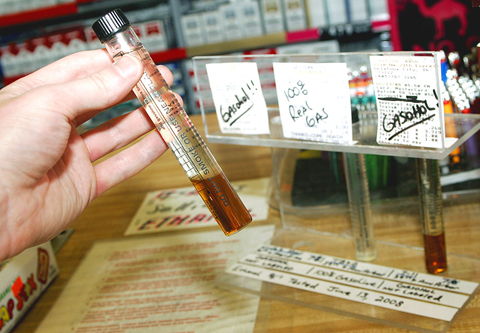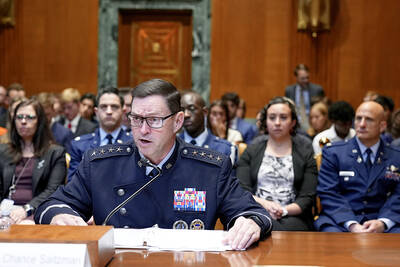“Why Do You Put Alcohol in Your Tank?” demands a large sign outside one gas station here, which reassures drivers that it sells only “100% Gas.”
“No Corn in Our Gas,” advertises another station nearby.
Along the highways of this sprawling prairie city, and in other pockets of the country, a mutiny is growing against energy policies that heavily support and subsidize the blending of ethyl alcohol, or ethanol, into gasoline.

PHOTO: NY TIMES NEWS SERVICE
Many consumers complain that ethanol, which constitutes as much as 10 percent of the fuel they buy in most states, hurts gas mileage and chokes the engines of their boats and motorcycles.
As ethanol has spread around the country, gas station owners and wholesalers are catering to concerns about ethanol that are often exaggerated but not entirely unfounded. High gas prices seem to be helping them plant seeds of doubt in customers’ minds.
“We just think it’s better for the car — we get better mileage,” said Marjorie Olbert, a retired teacher, as she filled her 2002 Toyota with what is sometimes called conventional or “clear” gasoline at a suburban E-Express station.
Stickers on the pump urge customers to “Always Demand 100% Real Gasoline.”
Olbert was unmoved by the slightly lower price of the blend.
“My husband and I just decided that the few cents difference is worth it,” she said.
Though common in the Midwest for at least a decade, ethanol-gas blends — often called gasohol — arrived on the coasts a few years ago and only recently started showing up in many southern states.
The expansion has been driven largely by federal measures requiring that 136 billion liters of biofuels a year be mixed into the nation’s gasoline supply by 2022. Last year, 25 billion liters of ethanol were mixed into a supply of 538 billion liters of gasoline.
Several states mandate ethanol blends, now found in two-thirds of the nation’s gas supply. Florida recently passed a requirement that will take effect in 2010.
Ron Lamberty of the American Coalition for Ethanol estimates that about a quarter of all gas stations across the country sell only ethanol blends, a quarter sell only unblended gas, and the other half offer both, or go back and forth depending on price.
Mike Brown, a vice president of Harris Oil, a wholesaler north of Orlando, has stuck to unblended gas, which he shuttles to large businesses like marinas and landscapers, even as many of his competitors switched to ethanol blends in May, after the changeover of a large supply terminal.
He used to deliver three or four tanker loads a week, but “we’ve added an extra load because of our new customers,” he said.
He also has a small fueling station where customers are starting to bring 19 liter gasoline cans or 208 liter drums to get their hands on ethanol-free gasoline.
The most common blend of ethanol is called E10, which is about 90 percent gasoline and 10 percent ethanol by volume. All modern nondiesel cars are certified to run on a blend of up to 10 percent.
(E85, a much higher ethanol blend of about 85 percent ethanol and 15 percent gasoline, is only for vehicles specifically designated “flex fuel.”)
Liter for liter, pure ethanol contains one-third less energy than gasoline, and the ethanol industry acknowledges that E10 reduces mileage by about 2 percent.
Some drivers think the change is greater. Chuck Mai, a vice president of AAA Oklahoma, reported that members of his organization have been blaming E10 for mileage drops of 8 percent to 20 percent.
Drivers in Tulsa, he said, are complaining to their service stations, saying: “‘I used to get 28 miles per gallon [12km per liter]; last time around, I’m getting 25 [10.6km per liter]. What’s going on?’”
In chat rooms at Edmunds.com and elsewhere, plenty of people are blaming ethanol for substantial mileage drops.
Auto drivers are not the only ones complaining.
Ashley Massey, a spokeswoman for the State Marine Board in Oregon, where an E10 mandate is being enforced this year, said that when E10 first arrived, her agency was flooded by calls.
“What we’re hearing is that the boats are starting, but then they start to sputter” and quit, she said.
They are also hard to restart, Massey said, adding that her own weed trimmer sputtered and died with E10, but revived with conventional gas.
Her agency has posted a list of gas stations that still sell unblended fuel, as permitted by exemptions to Oregon’s mandate, on its Web site. Warnings and tips about using E10 are included as well.
Mechanics for a range of equipment and small vehicles, from boats and motorcycles to lawnmowers, have blamed E10 for engine sputters and shutdowns.

FREEDOM OF NAVIGATION: The UK would continue to reinforce ties with Taiwan ‘in a wide range of areas’ as a part of a ‘strong unofficial relationship,’ a paper said The UK plans to conduct more freedom of navigation operations in the Taiwan Strait and the South China Sea, British Secretary of State for Foreign, Commonwealth and Development Affairs David Lammy told the British House of Commons on Tuesday. British Member of Parliament Desmond Swayne said that the Royal Navy’s HMS Spey had passed through the Taiwan Strait “in pursuit of vital international freedom of navigation in the South China Sea.” Swayne asked Lammy whether he agreed that it was “proper and lawful” to do so, and if the UK would continue to carry out similar operations. Lammy replied “yes” to both questions. The

Two US House of Representatives committees yesterday condemned China’s attempt to orchestrate a crash involving Vice President Hsiao Bi-khim’s (蕭美琴) car when she visited the Czech Republic last year as vice president-elect. Czech local media in March last year reported that a Chinese diplomat had run a red light while following Hsiao’s car from the airport, and Czech intelligence last week told local media that Chinese diplomats and agents had also planned to stage a demonstrative car collision. Hsiao on Saturday shared a Reuters news report on the incident through her account on social media platform X and wrote: “I

SHIFT PRIORITIES: The US should first help Taiwan respond to actions China is already taking, instead of focusing too heavily on deterring a large-scale invasion, an expert said US Air Force leaders on Thursday voiced concerns about the Chinese People’s Liberation Army’s (PLA) missile capabilities and its development of a “kill web,” and said that the US Department of Defense’s budget request for next year prioritizes bolstering defenses in the Indo-Pacific region due to the increasing threat posed by China. US experts said that a full-scale Chinese invasion of Taiwan is risky and unlikely, with Beijing more likely to pursue coercive tactics such as political warfare or blockades to achieve its goals. Senior air force and US Space Force leaders, including US Secretary of the Air Force Troy Meink and

‘BUILDING PARTNERSHIPS’: The US military’s aim is to continue to make any potential Chinese invasion more difficult than it already is, US General Ronald Clark said The likelihood of China invading Taiwan without contest is “very, very small” because the Taiwan Strait is under constant surveillance by multiple countries, a US general has said. General Ronald Clark, commanding officer of US Army Pacific (USARPAC), the US Army’s largest service component command, made the remarks during a dialogue hosted on Friday by Washington-based think tank the Center for Strategic and International Studies. Asked by the event host what the Chinese military has learned from its US counterpart over the years, Clark said that the first lesson is that the skill and will of US service members are “unmatched.” The second